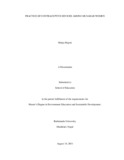
Please use this identifier to cite or link to this item:
https://hdl.handle.net/20.500.14301/221| Title: | PRACTICE OF CONTRACEPTIVE DEVICES AMONG MUSAHAR WOMEN |
| Authors: | Regmi, Manju |
| Citation: | Regmi, M.(2011).Practice of contraceptive devices among Musahar women |
| Issue Date: | 14-Aug-2011 |
| Department: | DODE |
| Level: | Masters |
| Program: | KUMSD |
| Abstract: | Reduction in population growth is believed to improve a country’s prospects for economic development, which subsequently is believed to enhance a country’s ability to improve the lives of its citizens. Rapid growth of population has been recorded since 1971 in Nepal. The same is now in the verge of double increase. There is no issue graver or more pressing than the rate of population growth in Nepal. It is thus that family planning and contraceptive devices are crucial components in saving the country from such a serious problem. The aim of this study was to analyze the use of contractive devices among the currently married Musahar women (The Musahar are an indigenous group. The indigenous communities of this country live in a terrible plight, both socially and economically. They are victims of economic, racial and social discrimination, and have no access to natural resources, technological knowledge or educational opportunities) in their reproductive age (15-49 years) in Chandraayodhayapur VDC of Siraha district. The socio-demographic factors, the personal factors, practice of using contraceptive devices and relation between ii practice and educational attainment were considered as research questions. This cross sectional survey was analyzed by taking a census. The data were collected through a pre tested interview schedule. The analysis of data was done using SPSS software. Descriptive statistic such as frequency, percentage, mean, standard deviation and cross tabulation were utilized in the analyzing of data. Of the 145 respondents, generated from a total of 562 females in the population, 91 percent of women were illiterate and their major occupation was labor. 71 percent had prior knowledge of at least one form of contraceptive. The most commonly known methods of contraception were injection, female sterilization and male sterilization. Of the total respondents, 6.2 percent had used contraceptives at least once in the past and 36.6 percent were currently using contraceptive devices. The use of contraceptive devices and the schooling of children were directly affected by the educational level of the women, as the women’s age occupation, and number of living sons. Encouragement from friends and the sense of materializing the norms of small family were found to be the leading contributing factors for the usage of contraceptive devices. Lack of knowledge of contraceptive devices, and the desire for a son were founded as the key factors which prevented the women from using a family planning method. |
| URI: | https://hdl.handle.net/20.500.14301/221 |
| Appears in Collections: | Research Project |
Files in This Item:
| File | Description | Size | Format | |
|---|---|---|---|---|
| manju Final_edited_LAST_FOR_HARD prakas.pdf | 1.17 MB | Adobe PDF |  View/Open |
Items in DSpace are protected by copyright, with all rights reserved, unless otherwise indicated.